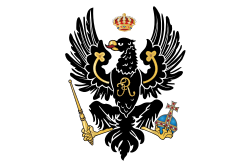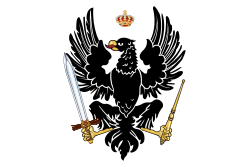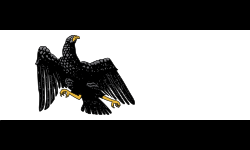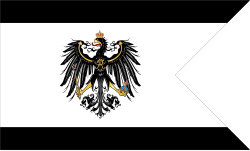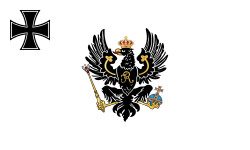- Flag of Royal Prussia
(1466–1772) - Flag of the Duchy of Prussia
(1525–1657) - State flag of the Kingdom of Prussia
(1701–1750) - State flag of the Kingdom of Prussia
(1750–1801) - State flag of the Kingdom of Prussia
(1801–1803) - State flag of the Kingdom of Prussia
(1803–1892) - State flag of the Kingdom of Prussia
(1892–1918) - Civil flag of Prussia
(1701–1935) - Civil ensign of the Kingdom of Prussia
(1892–1918) - War flag of Prussia
(1816) - War flag of Prussia
(1895–1918) - Royal Standard of the King of Prussia
(1871–1918) - Standard of the Crown Prince
(1871–1892) - Civil ensign and Merchant flag of the Kingdom of Prussia
(1823–1863) - Civil ensign and Merchant flag of the Kingdom of Prussia
(1863–1892) - Service flag of the Free State of Prussia
(1933–1935)
The state of Prussia had its origins in the separate lands of the Margraviate of Brandenburg and of the Duchy of Prussia. The Margraviate of Brandenburg developed from the medieval Northern March of the Holy Roman Empire, passing to the House of Hohenzollern in 1415. The Duchy of Prussia originated in 1525 when Albert of Brandenburg-Ansbach, a member of a cadet branch of the Hohenzollern house, secularized the eastern lands of the Teutonic Knights as a Polish fief. Prince-elector John Sigismund, Elector of Brandenburg, inherited the Duchy of Prussia in 1618, thus uniting Brandenburg and Prussia under one ruler in a personal union; the Elector's state became known as Brandenburg-Prussia. The Kingdom of Prussia formed when Elector Frederick III assumed the title of Frederick I, King in Prussia, on 18 January 1701.
Contents
Hohenzollern monarchical rule of Prussia ceased in 1918 after the fall of the German Empire in the aftermath of World War I; the Kingdom becoming instead the Free State of Prussia. The Allied Control Council decreed the formal abolition of the state of Prussia in 1947 following World War II.





